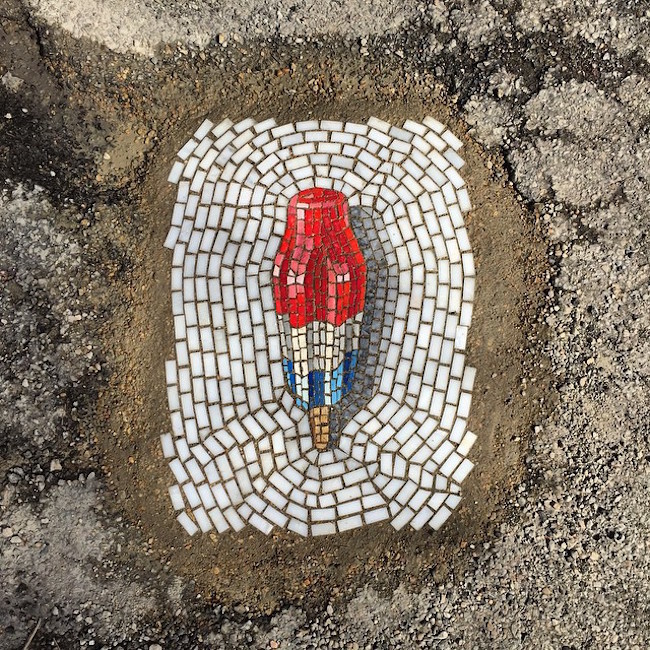Winter is coming, as they say. And with winter comes weather that turns your familiar morning commute into a craggy, pothole-filled nightmare. One or two good freezes and the entire neighborhood looks like it’s been shelled by an invading army. If your city is like most, these potholes could be rattling your brain inside your skull for the next eight months before they’re repaired.
How much negativity is born from potholes? They represent tiny aggressions, insignificant on their own, but in a mass they form a chorus of pain and agitation. They lay the groundwork for every miserable thing that happens to you post-commute, setting the tone for everything that follows. They’re too jarring to ignore by the dozen and yet, as a private citizen without access to an asphalt mixer, you’re powerless to do anything about them on your own. Well, unless you embrace anarchy and spraypaint penises around them like a guy in Pakistan did; let the bastards down at city hall try to ignore that.
But even with juvenile graffiti, the potholes still hold all of the power in this toxic relationship. This isn’t about “winning” a smoother drive through the city, no, this is a battle for your soul, for the soul of every commuter in the city. Nothing less than reframing the entire relationship will save you.
That’s what Chicago artist Jim Bachor does with his pothole interventions. Rather than treating them as something to be despised and fought against, what if they could be something that enhances their environment? Bachor, who is inspired by the timelessness of ancient mosaics, spent the summer of 2013 installing tile mosaics in potholes across Chicago. The subjects of these murals reframe your relationship to something that was previously hateful. Who can honestly say that they hate ice cream?

Bachor told Bored Panda in an interview:
“The project is really more about brightening peoples’ days in the tiniest of ways with something almost universally loved (like ice cream or flowers) unexpectedly fixing something universally hated (potholes),” Jim Bachor told Bored Panda. “No matter if you are young, old, rich, poor etc – everyone hates them. The longer I do this the more people recognize me in a positive way. I’ve even had a guy drop off a coffee and danish one cool morning I was working on a piece.”

It’s a storybook allegory for good karma. Bachor crafts tiny displays of his goodwill and that goodwill is returned to him almost immediately. At the risk of sounding saccharine, anyone can do this. It’s an art project that non-artists will invest in. People paid Bachor to do this. You could make a day out of these mosaics if you wanted to. Bachor left you a map.
Obviously, something like this won’t be sanctioned by the city. A spokesman warned people about attempting pothole art. Still, it’s amazing what you can get away with when you act like you know what you’re doing. No one scrutinized Bachor during his installations and he used the flimsiest disguise when he was starting out. Hyperallergic states:
Starting by his home in the northwest Chicago neighborhood of Mayfair, Bachor sectioned off work zones with his twin sons’ miniature orange soccer cones. Within the last year the artist has graduated to industrial-sized cones and a bright reflective vest, which increase Bachor’s visibility — yet a common passerby would likely mistake the artist for doing roadwork, not artwork.


In a tiny way, Bachor reframed reality for the people who experienced his work. If your relationship to the frustration of potholes can be subverted and turned into something pleasurable, what else can?
Bill Rodgers is the Managing Editor of cfile.daily.
Love contemporary ceramic art + design? Let us know in the comments.

Images courtesy of Jim Bachor.

When all else fails, go rogue, as this anonymous artist in Pakistan did. However: “He who fights with monsters should look to it that he himself does not become a monster. And when you gaze long into an abyss the abyss also gazes into you.” Photograph from Daily Pakistan Global.


Along similar lines the work of Rory MacDonald can be found in the book, Utopic Impulses: Contemporary Ceramic Practice, eds Ruth Chambers, Amy Gogarty and Mireille Perron, pub. Ronsdale Press, pp176-179. MacDonald’s ‘Curb Works’ identify areas of decay in the public works of a city (Regina, Saskatchewan) and attempts to question the value of material and actions within abject public spaces by repairing cavities and missing bits in city roadside curbs with specifically made decorated, and decorative, ceramics. These charming inserts into the borderlines around city spaces draw attention to potential for further restoration by ceramic means and values the physical effort involved in creating such repairs. They become engaging, even uplifting, interventions in to forlorn and degraded city-scapes.
Very cool! We need Jim to repair our potholes in Santa Fe.
this may be the most thoughtful write-up i’ve read about the pothole art installation project. stay tuned for more in the Spring of 2016. thank you!
Thanks, Jim! I had a great time writing about this. Let us know what you’re up to in the future!
Love it!!